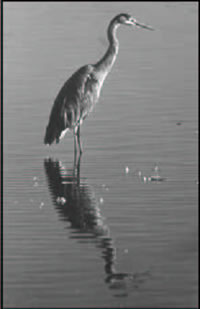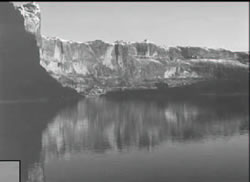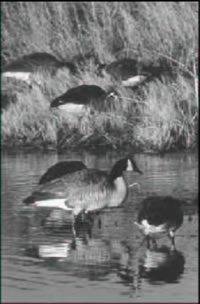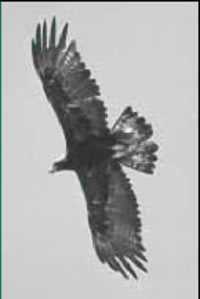|

 I
had the best seat in the house. Perched atop a hundred-foot
bluff along the banks of the Colorado River, I had a front
row seat to The River of Life. From my eyrie, I would watch
the annual rituals of Spring unfold before me. Stage left
was filled with the parental care of two bald eagles, our
nation’s symbol, as they alternated incubating their
precious eggs. The rim of the nest made of cottonwood twigs
blocked my view, but every so often I would watch as the incubating
bird would roll an egg with its beak to insure that all sides
were adequately warmed. The bird would stretch, cast a glance
upstream to watch as a pair of mallards noisily lifted off
of the water, then settle back down for his or her turn on
the egg. I
had the best seat in the house. Perched atop a hundred-foot
bluff along the banks of the Colorado River, I had a front
row seat to The River of Life. From my eyrie, I would watch
the annual rituals of Spring unfold before me. Stage left
was filled with the parental care of two bald eagles, our
nation’s symbol, as they alternated incubating their
precious eggs. The rim of the nest made of cottonwood twigs
blocked my view, but every so often I would watch as the incubating
bird would roll an egg with its beak to insure that all sides
were adequately warmed. The bird would stretch, cast a glance
upstream to watch as a pair of mallards noisily lifted off
of the water, then settle back down for his or her turn on
the egg.
Center stage was filled by a river island, severed from the
banks by several braids of the river. Clothed in cottonwoods,
the island offered safe havens to a number of different species.
Great blue herons maintained a rookery, an apartment complex
of nests, in one massive cottonwood. Individual herons would
fly low and slow, circling over the complex and uttering guttural
calls to their mates below. With amazing grace these long-legged
fishermen would descend into the crowd of limbs, then land
with a great fanfare. They would arch their heads skyward,
while their mate would dip their long necks downward. I was
a witness to their courtship, a cupid without any arrows,
a spectator to love.
Occasionally, one of the eagles would pass close by over the
herons, who, in turn, would squabble their protests. For the
most part they left each other alone, this duet of fisherfolk
living along the river.
Below the cottonwood trees the wild turkeys roamed. The toms
would puff themselves up and strut before the flocks of hens,
whose disinterest seemed to indicate who was the mightier
of the sexes. At times I could count more than 200 individuals,
scattered into several flocks. The turkeys didn’t mind
the herons; I even caught them sleeping in the bald eagle’s
nest tree one starlight evening.
 Foraging
along the braids of the river were the migrant waterfowl.
Mallards and green-winged teals would forage among the shallow
riffles, while the goldeneyes and mergansers, the males in
their snowy breeding plumage, would float the main current
diving for fish. Sometimes the flocks of geese that foraged
in the fields with the wild turkeys would get startled, spooked
by a large shadow or wary of a patrolling coyote. The flocks
would suddenly lift off in a great commotion of beating wings
and noisy calls, their honking reminding me of a Manhattan
traffic jam. Foraging
along the braids of the river were the migrant waterfowl.
Mallards and green-winged teals would forage among the shallow
riffles, while the goldeneyes and mergansers, the males in
their snowy breeding plumage, would float the main current
diving for fish. Sometimes the flocks of geese that foraged
in the fields with the wild turkeys would get startled, spooked
by a large shadow or wary of a patrolling coyote. The flocks
would suddenly lift off in a great commotion of beating wings
and noisy calls, their honking reminding me of a Manhattan
traffic jam.
 The
geese would scare the ducks into flight, some lifting off
like helicopters while others, like the mergansers, had to
take a run across the water to get airborne. The mix of geese
and ducks would then startle the herons, whose protest calls
became louder as they launched from their cottonwood springboards.
While this cacophony of sound would reverberate across the
river, the eagles would sit motionlessly in their nest or
atop their dead-tree perches. They would cast a glance at
the spectacle, but not join in the mayhem themselves. The
geese would scare the ducks into flight, some lifting off
like helicopters while others, like the mergansers, had to
take a run across the water to get airborne. The mix of geese
and ducks would then startle the herons, whose protest calls
became louder as they launched from their cottonwood springboards.
While this cacophony of sound would reverberate across the
river, the eagles would sit motionlessly in their nest or
atop their dead-tree perches. They would cast a glance at
the spectacle, but not join in the mayhem themselves.
Sometimes the ducks would fly right by my perch, nervously
looking my way. Other times they would circle about the islands
and bends in the river, constantly calling, ever vigil. Soon
peace and quiet would return; all would settle down to loaf
or feed or forage or court. What an endless cycle I would
think, ever amazed at the tenacity for survival exhibited
by these winged creatures along this River of Life.

|